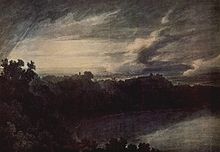|
John Robert Cozens
   John Robert Cozens (1752 – 14 December 1797) was a British draftsman and painter of romantic watercolour landscapes. Cozens executed watercolors in curious atmospheric effects and illusions which had an influence on Thomas Girtin and J. M. W. Turner. His poetic work included Alpine views and a sense of vastness.[citation needed] John Constable described Cozens as "the greatest genius that ever touched landscape." In June 2010 Cozen's Lake Albano (c.1777) sold at auction, at Sotheby's in London, for £2.4 million, a record for any 18th-century British watercolour.[1]  BiographyThe son of the Russian-born drawing master and watercolourist Alexander Cozens, John Robert Cozens was born in London. He studied under his father and began to exhibit some early drawings with the Society of Artists in 1767. In 1776 he displayed the large oil painting, A Landscape with Hannibal in His March Over the Alps, Showing to His Army the Fertile Plains of Italy (now lost) at the Royal Academy in London.[2] This painting was the only oil that Cozens exhibited at the Academy and was the inspiration for J. M. W. Turner's famous painting of 1812.[3] Between 1776 and 1779 he spent some time in Switzerland and Italy, where he drew Alpine and Italian views, and in 1779 he returned to London. In 1782 he made his second visit to Italy, accompanied by the author William Beckford, spending much time at Naples. In 1783 he returned to England. In 1789 he published a set of Delineations of the General Character ... of Forest Trees. He submitted his work to the Royal Academy but it was rejected, being judged as "not proper art". At the age of 42, three years before he died, he suffered a nervous breakdown and was committed to the Bethlem Royal Hospital asylum. The asylum's chief physician, Dr. Thomas Monro recognised Cozens' talent and bought his painting collection. Cozens died in London.[citation needed] Public collectionsSee alsoReferences
Further reading
External linksWikimedia Commons has media related to John Robert Cozens.
|